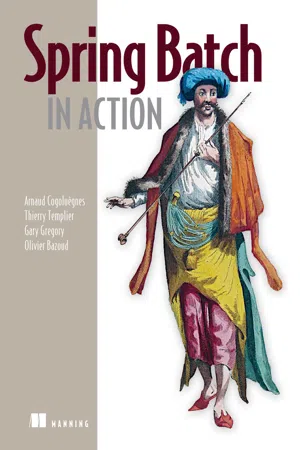
- 504 pages
- English
- ePUB (mobile friendly)
- Available on iOS & Android
Spring Batch in Action
About this book
Summary Spring Batch in Action is an in-depth guide to writing batch applications using Spring Batch. Written for developers who have basic knowledge of Java and the Spring lightweight container, the book provides both a best-practices approach to writing batch jobs and comprehensive coverage of the Spring Batch framework.
About the Technology
Even though running batch jobs is a common task, there's no standard way to write them. Spring Batch is a framework for writing batch applications in Java. It includes reusable components and a solid runtime environment, so you don't have to start a new project from scratch. And it uses Spring's familiar programming model to simplify configuration and implementation, so it'll be comfortably familiar to most Java developers.
About the Book
Spring Batch in Action is a thorough, in-depth guide to writing efficient batch applications. Starting with the basics, it discusses the best practices of batch jobs along with details of the Spring Batch framework. You'll learn by working through dozens of practical, reusable examples in key areas like monitoring, tuning, enterprise integration, and automated testing.No prior batch programming experience is required. Basic knowledge of Java and Spring is assumed. Purchase of the print book comes with an offer of a free PDF, ePub, and Kindle eBook from Manning. Also available is all code from the book.
What's Inside
- Batch programming from the ground up
- Implementing data components
- Handling errors during batch processing
- Automating tedious tasks
Table of Contents
PART 1 BACKGROUND
- Introducing Spring Batch
- Spring Batch concepts
- PART 2 CORE SPRING BATCH
- Batch configuration
- Running batch jobs
- Reading data
- Writing data
- Processing data
- Implementing bulletproof jobs
- Transaction management
- PART 3 ADVANCED SPRING BATCH
- Controlling execution
- Enterprise integration
- Monitoring jobs
- Scaling and parallel processing
- Testing batch applications
Frequently asked questions
- Essential is ideal for learners and professionals who enjoy exploring a wide range of subjects. Access the Essential Library with 800,000+ trusted titles and best-sellers across business, personal growth, and the humanities. Includes unlimited reading time and Standard Read Aloud voice.
- Complete: Perfect for advanced learners and researchers needing full, unrestricted access. Unlock 1.4M+ books across hundreds of subjects, including academic and specialized titles. The Complete Plan also includes advanced features like Premium Read Aloud and Research Assistant.
Please note we cannot support devices running on iOS 13 and Android 7 or earlier. Learn more about using the app.
Information
Part 1. Background
Chapter 1. Introducing Spring Batch
- Understanding batch applications in today’s architectures
- Describing Spring Batch’s main features
- Efficiently reading and writing data
- Implementing processing inside a job with Spring Batch
- Testing a Spring Batch job
1.1. What are batch applications?
Figure 1.1. A typical batch application: system A exports data to flat files, and system B uses a batch process to read the files into a database.

- Large data volume— Batch applications must be able to handle large volumes of data to import, export, or compute.
- Automation— Batch applications must run without user interaction except for serious problem resolution.
- Robustness— Batch applications must handle invalid data without crashing or aborting prematurely.
- Reliability— Batch applications must keep track of what goes wrong and when (logging, notification).
- Performance— Batch applications must perform well to finish processing in a dedicated time window or to avoid disturbing any other applications running simultaneously.
1.2. Meet Spring Batch
Table of contents
- Copyright
- Brief Table of Contents
- Table of Contents
- Foreword
- Preface
- Acknowledgments
- About this Book
- About the Cover Illustration
- Part 1. Background
- Chapter 1. Introducing Spring Batch
- Chapter 2. Spring Batch concepts
- Part 2. Core Spring Batch
- Chapter 3. Batch configuration
- Chapter 4. Running batch jobs
- Chapter 5. Reading data
- Chapter 6. Writing data
- Chapter 7. Processing data
- Chapter 8. Implementing bulletproof jobs
- Chapter 9. Transaction management
- Part 3. Advanced Spring Batch
- Chapter 10. Controlling execution
- Chapter 11. Enterprise integration
- Chapter 12. Monitoring jobs
- Chapter 13. Scaling and parallel processing
- Chapter 14. Testing batch applications
- Appendix A. Setting up the development environment
- Appendix B. Managing Spring Batch Admin
- Index
- List of Figures
- List of Tables
- List of Listings